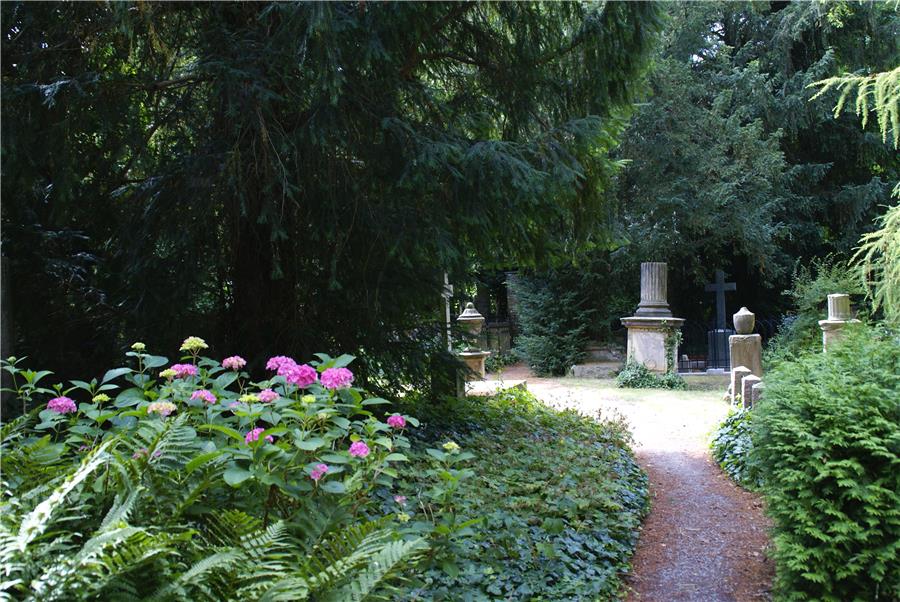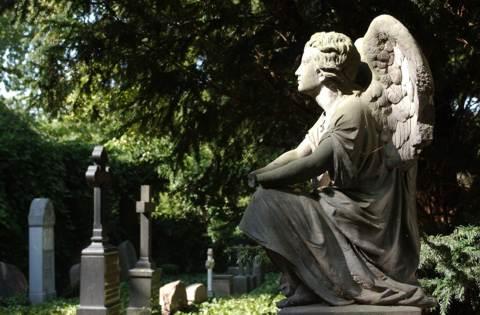About the cemetery
Theodor Fontane introduced what is probably the most famous Potsdam cemetery with the remark that, "What dies in Sanssouci will be buried in Bornstedt."
He was alluding to the numerous generals, army officers, chamberlains, valets, Privy Councillors, court doctors, and royal master-builders, "however, above all, court gardeners arrayed by the battalion."
The cemetery is distinguished not only by the grave of Heinrich Wilhelm Wagenführer, the only member of the famous 'tall fellow' grenadiers of the life guards battalion of the Soldier King to be laid to final rest here, but also the graves of Kurt von Plettenberg, the only participant in the ill-fated July 20, 1944 plot to overthrow Hitler who was to receive a regular funeral, and Ludwig Justi, the director of the National Gallery in Berlin for many years. In the private graveyard of the Sello family for example, the famous landscape gardener Peter Joseph Lenné and the architects Friedrich Ludwig Persius and Ferdinand von Arnim were buried.
The church, with its detached campanile, was built in 1842-43 in an Italianesque style according to the wishes of King Frederick Wilhelm IV and by the plans of Friedrich Ludwig Persius. Friedrich August Stüler was charged with the further design and realization of the building. Reinhold Persius completed the work in 1881-82 and gave the Bornstedt church its final form, which it still retains. The unusual memorial slab of Jacob Paul von Gundling can be seen within the building, as well as some other noteworthy exhibits.
Contact
Bornstedt Cemetery
Ribbeckstraße
Potsdam-Bornstedt
Phone: +49 (0)331 - 52 05 68
Opening hours
Every day throughout the year
Entrance is free
*Content resource: Potsdam.de
Theodor Fontane introduced what is probably the most famous Potsdam cemetery with the remark that, "What dies in Sanssouci will be buried in Bornstedt."
He was alluding to the numerous generals, army officers, chamberlains, valets, Privy Councillors, court doctors, and royal master-builders, "however, above all, court gardeners arrayed by the battalion."
The cemetery is distinguished not only by the grave of Heinrich Wilhelm Wagenführer, the only member of the famous 'tall fellow' grenadiers of the life guards battalion of the Soldier King to be laid to final rest here, but also the graves of Kurt von Plettenberg, the only participant in the ill-fated July 20, 1944 plot to overthrow Hitler who was to receive a regular funeral, and Ludwig Justi, the director of the National Gallery in Berlin for many years. In the private graveyard of the Sello family for example, the famous landscape gardener Peter Joseph Lenné and the architects Friedrich Ludwig Persius and Ferdinand von Arnim were buried.
The church, with its detached campanile, was built in 1842-43 in an Italianesque style according to the wishes of King Frederick Wilhelm IV and by the plans of Friedrich Ludwig Persius. Friedrich August Stüler was charged with the further design and realization of the building. Reinhold Persius completed the work in 1881-82 and gave the Bornstedt church its final form, which it still retains. The unusual memorial slab of Jacob Paul von Gundling can be seen within the building, as well as some other noteworthy exhibits.
Contact
Bornstedt Cemetery
Ribbeckstraße
Potsdam-Bornstedt
Phone: +49 (0)331 - 52 05 68
Opening hours
Every day throughout the year
Entrance is free
*Content resource: Potsdam.de


20
Bornstedt Cemetery, Potsdam, Germany, description, member of ASCE, part of European Cemeteries Route